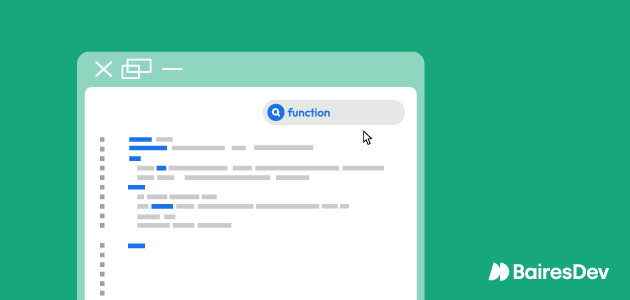What makes an IDE worthy of its developers?

Your developers rely on very specific tools to do their work. While some developers prefer to work strictly from the command line, most choose to use an Integrated Development Environment (IDE) for the tasks at hand. With the right IDE, a developer is better equipped to write high-quality code and meet release deadlines. With the wrong tool, the developer's job becomes exponentially more difficult.
But what constitutes a good IDE? Given that every developer uses their IDE differently and how many IDEs are available, this question can seem a bit nebulous. However, there are certain features that most developers agree are essential to their work.
If you've never used an IDE or are looking to purchase or deploy IDEs for your developers, here is a list of features that most developers will find indispensable.
Incremental search

A good search feature is essential for an IDE. There are 2 types of popular searches: Quick Search and Incremental Search. When using Quick Find, the IDE will find the first instance of a search string and highlight the remaining found entries. To move to the next entry, you must press additional key combinations to advance.
With Incremental Search you simply press the same key combination to move from one move to another, making this type more efficient. Developers who prefer efficiency over increased resources prefer Incremental Search over any other type because it is much easier to keep pressing the same key combination to move from one stroke to another.
Smart autocomplete

Intelligent autocompletion (also known as smart code completion) is context-aware code completion. This is very similar to what you find on your smartphone. As you type, the device tries to anticipate what you are about to type and automatically completes it for you. In the domain of IDEs, smart autocomplete is aimed at programming languages, so it is smart enough to autocomplete in the language of your choice.
This type of feature not only makes the developer's work more efficient but also more accurate. It provides a convenient method for accessing function descriptions and parameter lists while helping developers make fewer errors when typing.
Background compilation

Not every IDE features background compilation. Those that do really stand out to developers. That's because this feature presents a complete list of errors as developers type. As the name implies, Background Compilation runs in the background, which allows developers to compile and work (even on the files they are compiling) at the same time.
Builds run as separate, parallel threads. However, there are some restrictions on using background compilation, such as the inability to close a compilation project, change the active project, run or debug another application, do refactoring, or start another compilation.
Split screen mode
Split screen mode is an invaluable feature in an IDE because it allows developers to easily compare 2 files side by side or even compare 2 different parts of the same document. This makes it much easier for developers to find errors, work more efficiently, and avoid the eye strain associated with switching between windows.
Code refactoring
Refactoring is the process of restructuring or cleaning up code without changing or increasing its external behavior. Refactoring happens a lot. You'll have developers release an app, only to realize they wrote confusing code in their rush to meet deadlines. They will go back and clean up that code to make it easier to read or reuse.
Some IDEs include automated refactoring tools. After using this built-in tool, you can preview the refactoring changes and apply them (if the changes are acceptable).
Integrated build tools
Build tools include those that can download dependencies, compile sources, package binary code, run tests, and deploy to production systems. Not every IDE includes all of these features, but it's important to ensure that the IDEs your developers use have at least some of them.
Integrated build tools make developer work less tedious and more efficient.
Syntax highlighting
Syntax highlighting is a very common feature in IDEs. It highlights code in different colors or fonts depending on a specific category of terms. This feature makes the code much easier to read and work with. Syntax Highlighting also makes code easier to implement, as highlighting is done in real time, meaning errors can be detected much more easily.
Key/tag matching
Nested keys and tags can become very complicated. And when an opening brace doesn't have its corresponding closing brace, errors will occur. Some IDEs include brace and tag matching, so when a developer types an opening brace ({), the text editor will automatically add the closing brace (}). This not only helps you avoid mistakes but also makes work more efficient.
Code folding
A single file in a project can be very long. Therefore, when a developer needs to compare one section of the file with another, having to constantly scroll up and down to make the comparison can not only be confusing, but also a recipe for error.
Cold Folding allows you to hide sections of the file, so that the two parts being compared are immediately above and below each other. Think of Code Folding as if you are folding a piece of paper so that everything except the top and bottom is hidden, so you can only see what you want.
Git/GitHub integration
Almost all developers work with Git or GitHub. This is especially true when working in a team or in a DevOps environment. Some IDEs include built-in integration with Git and GitHub. With this feature, your developers can do most of their work in a single tool. There is no need to manually import code from a repository into the IDE and then export the new code to the repository when you are done working.
Integration between Git and GitHub should probably be considered mandatory for any IDE you use.
Conclusion
Every project and developer's needs are different. But every developer works with an IDE and will have a list of key features that match or come close to that list. Even if your developers demand more from their IDEs, this list should serve as a good starting point to help you find the right IDE for the job.




















































